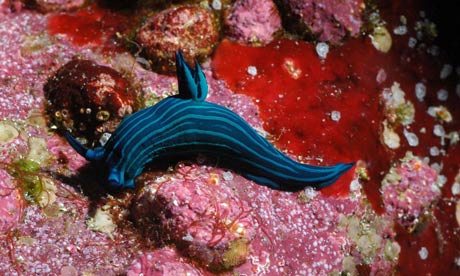
Scientists have discovered three new coral species - and one that was thought to be extinct - in an extensive survey of reefs around the Galapagos Islands, raising hopes that reefs may be more resilient to rising sea temperatures than previously thought.
Honeycomb coral (Gardineroseris planulata) had apparently been wiped out in in 1997-98 by the last big El Niño event. This natural periodic event affects weather globally and another is expected this year. But the study around the relatively unexplored areas of the coasts of Wolf and Darwin islands to the north-west of the main archipelago turned up several separate colonies.
Warmer sea temperatures caused by climate change and periodic El Niño events have caused large areas of coral to be wiped out in so-called "bleaching" events. Many scientists, as reported in the Guardian last week, fear that concentrations of CO2 in the atmosphere are already high enough to ensure a mass extinction of coral in the coming decades.
Professor Terry Dawson of Southampton University carried out the marine survey along with scientists from the University of Miami, covering an area that had not been studied extensively by marine biologists since the 1970s. The three new coral species are from the genera Hydrozoanthus, Parazoanthus and Antipathozoanthus. They also found a fourth possible new species and other corals that were thought not to inhabit the waters around the Galapagos.
Coral reefs are formed by deposits of calcium carbonate left by successive generations of tiny polyps which feed off plankton. They also receive nutrients from symbiotic algae known as zooxanthellae which also give coral their bright glowing colours. As temperatures rise, the algae dies or is ejected by the polyps, which leads to coral bleaching. In 1982 - 83 an El Niño event killed off around 95% of the coral in the Galapagos and caused severe disruption to the marine ecosystem there. In 1997 - 98 ocean warming caused a second bout of bleaching.
Dawson, who published his team's findings in the peer-reviewed journal Galapagos Research last month, said that it appeared the algae might be adapting to warmer ocean temperatures. Sea temperatures in the Galapagos vary between 23C and 29C in normal years, but can rise to 30C in El Niño years.
"Our study might suggest that species are more resilient than we thought. Nature is quite capable of looking after itself," he said. "Humans have such short timescales in looking at things. A lot of coral dies off after an El Niño event. But we don't give species enough time to do what it needs to do. We worry about rapid climate change and its effects but some species can adapt to climate change quite quickly too."
Dawson plans to return to the Galapagos after finding evidence of a migratory corridor from the Ecuadorian archipelago, up to Panama and Costa Rica, for whale sharks (the world's largest fish), hammerhead sharks and a number of other marine animals.
Andrew Baker, assistant professor at the Rosenstiel School of Marine and Atmospheric Science in Miami who led the research into the so-called algal symbionts, said he had found some evidence to suggest thermal tolerance since he started collecting data in 1998.
"Many people describe the Galapagos as nature's laboratory and that is true of its reefs too. We can look at the reef in the Galapagos and use it as a model of the system to see what reefs around the world might look like in 30-50 years," said Baker.



Reader Comments
to our Newsletter